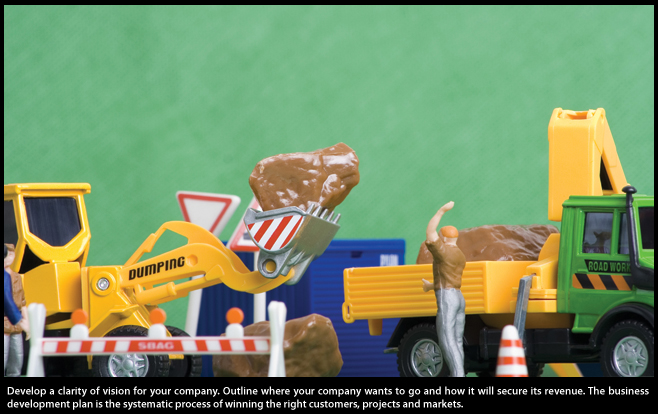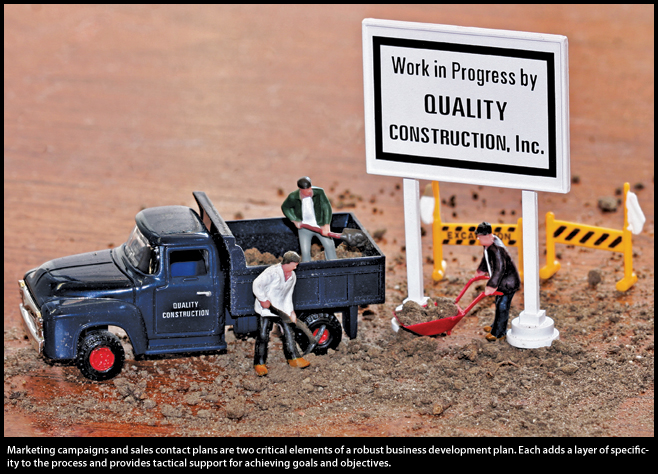Business Development Simplified
Despite significant differences in the operating environment between 1912 and 2012, the underlying principles behind business development are the same: Win the right volume of the right type of work with the right customers for the businesses to be profitable and achieve its strategic goals. These principles apply whether the goals are to grow within its existing markets, enter new markets or simply maintain market share.
Business development as a term has many different meanings in the industry. To some, business development represents the people whose responsibility is building relationships. For others, it is the work done by everyone in the company to target, win and maintain customer relations over the long haul. For purposes of this article, business development is the strategic integration of marketing, sales and customer service efforts. It is the work of understanding what the customer values and systematically delivering that value over the life of the relationship. Ideally, business development is meeting the needs of the customer in a way that no competitor can readily match.

Business development, when effectively executed, is the work of everyone in the company. Its purpose is to create and deliver a consistent customer experience. Business development is more than a department, a group of people or a clever marketing tagline. Instead, for “best-of-class” contractors, business development is a central element of the firm’s overall strategy.
The 2012 business development survey conducted by the construction management consultants at FMI, in conjunction with the Associated General Contractors of America, clearly identifies that a number of contractors are in the process of transitioning from business development as an island to business development as an integral piece of the firm’s strategic vision. The firms that remain stuck are focused on reactive measures for targeting and winning projects. This difference is best seen in the disparity among survey respondents with regard to profitability, backlog composition and repeat business. For the reactive companies, the economic tumult of the last few years has been deeply felt.
Creating Your Competitive Advantage
The design of a firm’s business development function should result from the firm’s strategy and sources of competitive advantage. Reputation and relationships are certainly keys to winning the right work. When you are competing against the biggest and best contractors, however, your competitors also have great reputations and deep experience. The real value is how your reputation and relationships translate into specific value for your current and prospective customers. The value received by the customer is at the heart of any competitive advantage. It is nice if the customer knows you have deep experience or a good reputation, but if you cannot translate both of those into tangible and, ideally, quantifiable benefits to the customer, what is going to keep them from choosing another contractor for the next project?

What is it about your deep experience or reputation that truly sets you apart from your competition in a way that your customer will value? That is the key selling message and what you need to deliver on each and every project. It all starts with the creation of a strategic business development plan.
Elements of a Strategic Business Development Plan
1. Strategic Vision
Develop a clarity of vision for your company. It is the beginning of every effective business development plan. It outlines where your company wants to go and how it will secure its revenue. The business development plan is the systematic process of winning the right customers, projects and markets.
2. Competitive Assessment
Build on facts. Include market research to get an accurate look at competitors. The key is to identify where competitors are positioned in the mind of the customer, what they promise/deliver and where opportunities exist to differentiate your firm.
3. Customer Research
Investigate overall customer satisfaction. Understand what customers value from contractors in general and of your company specifically. Then investigate the criteria customers use to select contractors and how you and the competition measure up. Research should also include the following:
- Market sizing and forecasting
-
Company image analysis
-
Customer buying practices
-
Customer satisfaction and loyalty
4. Value Propositions
Give them a reason to pick you. The center of a customer-focused strategy, your value proposition answers the specific question of what your company brings to customers, the benefit and how that differs from competitors. It builds on the company’s core competencies and capabilities while aligning with a deep customer understanding. Successful contractors know their value propositions at a market segment, key customer and specific project level.

5. Go-to-Market Strategies
Create a compelling strategy to break in and grow customers, market segments and geographies. These are at the heart of all effective business development plans. The strategy will outline how revenue is targeted and won. It will identify proactive market activities of your company: which customers, what types of work, services provided and the opportunity-specific win strategies needed to secure the work. One set of go-to market strategies should focus on maintaining and growing value delivered to existing customers, with the goal of driving repeat business and loyalty. Other go-to market strategies focus on expanding new customers, markets and geographies.
6. Traction Elements for Implementation
Drive for results. The following represent the infrastructure elements of plan implementation. The more of these elements that are tied to each strategy, the greater the probability a strategy will achieve full implementation and be driven into the fabric of your company.
Organizational structure and roles — Do you have enough of the right people in the right places to drive results? Consider the following:
Skills, training and development — What skills and tools are needed to support the effort?
Resources — What time, money and people are needed to achieve the plan?
Rewards and feedback — What feedback and rewards are needed to support people through implementation? Do the feedback and rewards support the right behavior or derail the best-laid plans?
Measurements and metrics — How will you track the success of plan implementation? This should include both leading and lagging indicators.
7. Strategies and Key Actions
Determine “how” you will win. Built around the traction elements outlined in No. 6, these identify the infrastructure needed to support successful plan execution. Strategies define how to achieve the objectives of the plan.
8. Plan Development
Build a road map. The culmination of the research and planning phases, this is where final decisions are made, priorities set, commitments made and team buy-in is captured.
9. Market Campaigns and Sales Contact Plans
Marketing campaigns and sales contact plans are two critical elements of a robust business development plan. Each adds a layer of specificity to the process and provides tactical support for achieving goals and objectives.
10. Business Development Scorecard
Measure your progress. The scorecard ties the company vision to key elements of the plan. It provides both leading and lagging indicators of plan successes, challenges and struggles. The scorecard frames the results being accomplished in real time and sets the foundation for measuring return on dollars and time invested.
11. Target Customers and Projects
Pick the right targets. Targeting focuses efforts to increase hit rates and jump-start get-work effectiveness. The targeting portion of the plan matches the right amount of resources to apply to each opportunity or customer. It sets the stage for discriminating people, service and time where you have the greatest probability of winning work. Part of a robust go/no-go process, targeting quantifies the right level of resources to invest in each opportunity.
Cynthia Paul is FMI’s practice leader for business development. She works with industry firms to position them to capture market share and grow profitably, helps contractors stand out from the competition by discovering their differentiated platform and works in tandem with project teams to create the win strategy and delivers key projects. She can be reached at 303-398-7206 or via e-mail at cpaul@fminet.com.
The Quick Construction Forecast
According to FMI’s Second Quarter 2012 Construction Outlook Report
Housing Up, Nonresidential Mixed
New housing is slowly getting better, but residential construction is coming back led by 32 percent growth in multi-family housing. In nonresidential construction the forecast is mixed with healthcare and manufacturing showing the most positive signs of growth.
Lodging and Office Steadily Spread
Lodging construction put-in-place (CIPP) is expected to grow 4 percent and rebound somewhat to 7 and 8 percent in 2013 and 2014. Office construction should be 4 percent by the end of 2012 and improve to around 6 percent for 2013 through 2014.
Highway and Religion Sputter
It looks like religious construction will be flat in 2012, with the possibility of a “revival” in 2013 to 6 percent growth at $4.3 billion. Highway CIPP will drop 2 percent in 2012 and grow just 1 percent in 2013 to reach $77.7 billion or back near 2007 levels.
